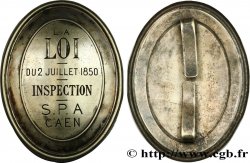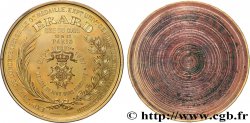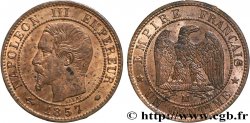v48_0836 - Faux pour servir (?) de 50 francs or Napoléon III, tête laurée 1862 Paris F.548/1 var.
MONNAIES 48 (2011)
Starting price : 680.00 €
Estimate : 1 000.00 €
Realised price : 680.00 €
Number of bids : 1
Maximum bid : 725.00 €
Starting price : 680.00 €
Estimate : 1 000.00 €
Realised price : 680.00 €
Number of bids : 1
Maximum bid : 725.00 €
Type : Faux pour servir (?) de 50 francs or Napoléon III, tête laurée
Date: 1862
Mint name / Town : Paris
Quantity minted : 24.418
Metal : gold
Millesimal fineness : - ‰
Diameter : 28,13 mm
Orientation dies : 6 h.
Weight : 11,61 g.
Edge : en relief : *****DIEU*PROTEGE*LA*FRANCE
Rarity : R3
Coments on the condition:
Importantes traces de monture soudées sur la tranche et des traces de nettoyage dans les champs
Catalogue references :
Predigree :
Cet exemplaire provient de MONNAIES 44 n° 874
Obverse
Obverse legend : NAPOLEON III EMPEREUR.
Obverse description : Tête laurée de Napoléon III à droite, un ruban descendant sur l'épaule ; au-dessous (différent de Directeur) / BARRE.
Reverse
Reverse legend : EMPIRE FRANÇAIS.
Reverse description : 50 FR de part et d'autre d'une aigle éployée sur un foudre entourée du collier de la Légion d'honneur brochant sur deux sceptres (main de justice et sceptre de Charlemagne) posés en sautoir, reposant sur une tenture ornée de mouchetures d'hermine à l'intérieur et d'abeilles à l'extérieur et sommée d'une couronne impériale de laquelle partent deux rubans, 1862 encadré de la lettre d'atelier A et du différent ancre de Graveur général au-dessous entre les extrémités des sceptres.
Commentary
Ce faux est bien entendu indiscutable, la différence de poids étant sans appel. En revanche, s’agit-il d’un faux de bijouterie ou d’un faux pour servir ? La question reste ouverte mais penche, pour nous, vers le faux pour servir, seule justification de la différence de poids. Un faux de bijouterie, certainement pour l’Algérie, patrie des ceintures dont la boucle faite d’une 50 francs laurée, n’a aucun intérêt ni à être d’une telle qualité ni à peser quatre grammes de moins puisque les bijoux se vendent, en Algérie comme dans tous les pays arabes, sur la base du poids.
La qualité du faux est plus qu’impressionnante : la pièce provient d’une collection par dates et fut manifestement vendue et achetée (par le collectionneur, pas par nous) comme authentique. La finesse du détail, la netteté et la franchise de la frappe en font un faux redoutablement dangereux, même pour un oeil exercé, et nous n’avons jamais vu de faux de bijouterie de ce modèle d’une telle qualité. Il nous semble donc probable que ce faux fut fabriqué pour servir, procurant au faussaire une quinzaine de francs de bénéfice.
La qualité du faux est plus qu’impressionnante : la pièce provient d’une collection par dates et fut manifestement vendue et achetée (par le collectionneur, pas par nous) comme authentique. La finesse du détail, la netteté et la franchise de la frappe en font un faux redoutablement dangereux, même pour un oeil exercé, et nous n’avons jamais vu de faux de bijouterie de ce modèle d’une telle qualité. Il nous semble donc probable que ce faux fut fabriqué pour servir, procurant au faussaire une quinzaine de francs de bénéfice.








 Report a mistake
Report a mistake Print the page
Print the page Share my selection
Share my selection Ask a question
Ask a question Consign / sell
Consign / sell
 Full data
Full data



